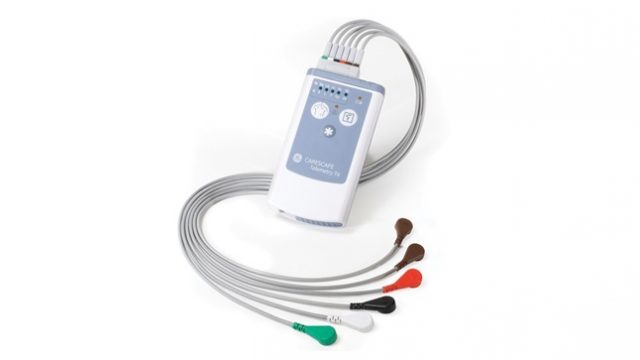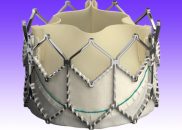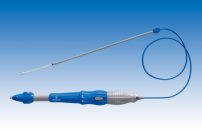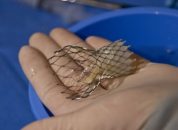Original Title: The Electrocardiogram after Transcatheter Aortic Valve Replacement Determines the Risk for Post-Procedural High-Degree AV Block and the Need for Telemetry Monitoring Reference: J Am Coll Cardiol Intv. 2016;9(12):1269-1276. Courtesy of Dr. Agustín Vecchia. So far, we have not been able to determine the moment high degree atrioventricular block (AVB) takes place after…
Aortic Angulation: Impact on the Success of TAVR
Original Title: Aortic Angulation Attenuates Procedural Success Following Self-Expandable But Not Balloon-Expandable TAVR. Reference: Abramowitz Y et al. JACC Cardiovasc Imaging. 2016 Jul 8. [Epub ahead of print]. The angulation degree between aorta and heart can make precise valve implantation challenging, especially extreme angulation, such as a horizontal aortic root. As obvious as it…
Valve-in-Valve: High or Low Implantation for Better Outcomes?
Original Title: Transcatheter Replacement of Failed Bioprosthetic Valve. Large Multicenter Assessment of the Effect of Implantation Depth on Hemodynamics after Aortic Valve-in Valve. Reference: Matheus Simonato, et al. Circ. Cardiovasc. Interv 2016;9:e003651 Courtesy of Dr. Carlos Fava. At present, most patients undergoing surgical valve replacement receive a bioprosthetic valve, which lasts from 10 to…
Medtronic’s New CoreValve Evolut R for TAVR
Original Title: Treatment of Symptomatic Severe Aortic Stenosis with a Novel Resheathable Supra-Annular Self-Expanding Transcatheter Aortic Valve System. Reference: Ganesh Manoharan et al. J Am Coll Cardiol Intv. 2015; 8(10):1359-1367. Courtesy of Dr. Agustín Vecchia. Despite the rapid growth and evolution of transcatheter aortic valve replacement devices (TAVR), vascular access complications, paravalvular leak, stroke…
Low gradient and LV Dysfunction: TAVI or not?
Original Title: Impact of ejection fraction and aortic valve gradient on outcomes of transcatheter aortic valve replacement. Reference: Baron SJ et al. J Am Coll Cardiol. 2016;67:2349-2358. Low aortic valve gradient and left ventricular dysfunction are frequent in patients with severe aortic stenosis undergoing transcatheter aortic valve replacement (TAVI) but only low aortic valve…
Bad prognosis in patients with aortic regurgitation post TAVI
Original Title: Aortic Regurgitation Following Transcatheter Aortic Valve Replacement: Impact of Preprocedural Left Ventricular Diastolic Filling Patterns on Late Clinical Outcomes. Reference: Amir Halkin, et al. Catheterization Cardiovascular Intervention 2016;87:1156-1163. Courtesy of Dr. Carlos Fava. Even though the mechanisms underlying post TAVI aortic regurgitation (ARpost) remain unclear, there is no question this complication is…
TAVI in asymptomatic severe aortic stenosis?
Original Title: Natural history, diagnostic approaches, and therapeutic strategies for patients with asymptomatic severe aortic stenosis. Reference: Généreux P et al. J Am Coll Cardiol. 2016; Epub ahead of print. Given that transcatheter aortic valve replacement (TAVI) is now being prescribed to lower risk patients, some wonder whether it is time to study the benefit…
TAVR with Sapien XT: similar to surgical replacement in intermediate risk patients
Original Title: Transcatheter or Surgical Aortic-Valve Replacement in Intermediate-Risk Patients. PARTNER 2A. Reference: Martin B. Leon et al. NEJM April 2, 2016 Courtesy of Dr. Juan A. Terré Studies have shown mortality rates after transcatheter aortic valve replacement (TAVR) and surgical aortic valve replacement (SAVR) in high risk patients are similar (PARTNER 2 – Cohort B). This is…
TAVI in Low-Flow / Low-Gradient
Original Title: Transcatheter Aortic Valve Implantation for Paradoxical Low-Flow Low-Gradient Aortic Stenosis Patients. Reference: Nicolas Debry et al. Catheter Cardiovasc Interv. 2016 Mar;87(4):797-804. Courtesy of Dr. Carlos Fava. Approximately 10 to 13% of low-flow low-gradient severe aortic stenosis cases (LF-LG) have preserved left ventricular function. Its physiopathology remains unclear and it has been associated with a…
TAVI in ≥90 year old patients: as beneficial as in younger patients
Original Title: Should Transcatheter Aortic valve replacement Be Performed in Nonagenarians? Insights from the STS/ACC TVT Registry. Reference: Mani Arsalan et al. J Am Coll Cardiol. 2016 Mar 29;67(12):1387-95. Courtesy of Dr. Carlos Fava The benefit of the transcatheter aortic valve replacement (TAVI) has already been shown in the general population undergoing this procedure. The number…









